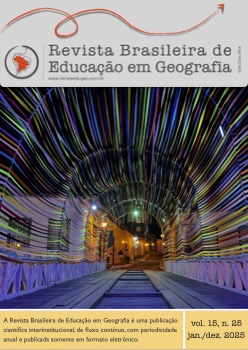Análise espacial no ensino de Geografia da Educação Básica
DOI:
https://doi.org/10.46789/edugeo.v15i25.1562Palavras-chave:
Análise Espacial, Educação Básica, Recursos tecnológicos, Geografia, Inteligência ArtificialResumo
A incorporação tecnológica no ensino de Geografia, nas últimas décadas, pode ser considerada crescente, ainda que heterogênea. Há muitos estímulos para inovar as atividades em sala de aula, no entanto, inúmeros professores têm experiências superficiais com tecnologias e sérias restrições de tempo para desenvolver novas habilidades. O objetivo do artigo é sistematizar os procedimentos elementares para orientar o uso da Análise Espacial na Educação Básica de Geografia. As relações topológicas (adjacência, conectividade e continência) entre as representações vetoriais (ponto, linha e polígono) foram abordadas em diferentes meios, como o manual, celular, web, Sistema de Informações Geográficas e Inteligência Artificial. O pressuposto é de que a Análise Espacial pode contribuir para abordar temas estruturantes, interdisciplinares ou associados aos itinerários formativos, como: localização, distância e escala. Constatou-se que o sucesso da inovação tecnológica em sala de aula depende do equilíbrio entre prudência e ousadia. E, que é fundamental inserir as tecnologias em um contexto pedagógico coerente e vinculado a uma progressão de perguntas, de forma a relacionar as informações obtidas a uma rede integrada de conteúdos geográficos. Os resultados mostram que o maior desafio é selecionar recursos didáticos e simples, gratuitos ou de baixo custo, e que sua incorporação, por alunos e professores, demande reduzido número de horas.
Palavras-chave
Análise Espacial; Educação Básica; Recursos tecnológicos; Geografia; Inteligência Artificial.
Spatial analysis in teaching Geography in Basic Education
Abstract
The incorporation of technology into Geography teaching in recent decades can be considered growing, although heterogeneous. There are many incentives to innovate classroom activities; however, many teachers have superficial experience with technology and serious time constraints to develop new skills. The objective of the article is to systematize the elementary procedures to guide the use of Spatial Analysis in elementary Geography education. The topological relationships (adjacency, connectivity and containment) between vector representations (point, line and polygon) were addressed in different media, such as manual, mobile, web, Geographic Information System and Artificial Intelligence. The assumption is that Spatial Analysis can contribute to addressing structuring, interdisciplinary themes or those associated with educational itineraries, such as location, distance and scale. It was found that the success of technological innovation in the classroom depends on the balance between caution and boldness. And that it is essential to insert technologies in a coherent pedagogical context and linked to a progression of questions, to relate the information obtained to an integrated network of geographic content. The results show that the biggest challenge is to select simple, free or low-cost teaching resources, and that their incorporation by students and teachers requires a small number of hours.
Keywords
Spatial Analysis; K–12 education; Technological resources; Geography; Artificial Intelligence.
Análises espacial en la enseñanza de la Geografia en la Educación Básica
Resumen
La incorporación de la tecnología a la enseñanza de la Geografía en las últimas décadas puede considerarse creciente, aunque heterogénea. Existen muchos incentivos para innovar las actividades en el aula, sin embargo, muchos docentes tienen una experiencia superficial con la tecnología y serias limitaciones de tiempo para desarrollar nuevas habilidades. El objetivo del artículo es sistematizar los procedimientos elementales para orientar el uso del Análisis Espacial en la educación básica em Geografía. Se abordaron las relaciones topológicas (adyacencia, conectividad y continencia) entre representaciones vectoriales (punto, línea y polígono) en diferentes medios, como manual, teléfono celular, web, Sistema de Información Geográfica e Inteligencia Artificial. Se asume que el Análisis Espacial puede contribuir a abordar temas estructurantes, interdisciplinares o asociados a itinerarios de formación, tales como: ubicación, distancia y escala. Se encontró que el éxito de la innovación tecnológica en el aula depende del equilibrio entre la prudencia y la audacia. Y es imprescindible insertar las tecnologías en un contexto pedagógico coherente y vinculado a una progresión de preguntas, con el fin de relacionar la información obtenida con una red integrada de contenidos geográficos. Los resultados muestran que el mayor desafío es seleccionar recursos didácticos sencillos, gratuitos o de bajo coste, y que su incorporación por parte de alumnos y docentes requiere un número reducido de horas.
Palabras clave
Análisis Espacial; Educación básica; Recursos tecnológicos; Geografía; Inteligencia Artificial.
Downloads
Referências
BAILEY, T. C. A review of statistical spatial analysis in geographical information systems. In: FOTHERINGHAM, S.; ROGERSON, P. (Eds.). Spatial Analysis and GIS. Basingstoke: Taylor & Francis, 1994. p. 13-44. DOI: https://doi.org/10.4324/9780203221563_chapter_2
BARNES, T. J. Geography’s underworld: The military-industrial complex, mathematical modelling and the quantitative revolution. Geoforum, v. 39, n. 1, p. 3–16, 2008. DOI: https://doi.org/10.1016/j.geoforum.2007.09.006
BATTERSBY, S. E.; GOLLEDGE, R. G.; MARSH, M. J. Incidental learning of geospatial concepts across grade levels: Map overlay. Journal of Geography, v. 105, n. 4, p. 139-146, 2006. DOI: https://doi.org/10.1080/00221340608978679
BEDNARZ, S. W. Geographic information systems: A tool to support geography and environmental education? GeoJournal, v. 60, p. 191-199, 2004. DOI: https://doi.org/10.1023/B:GEJO.0000033574.44345.c9
BERRY, B. J. L.; GRIFFITH, D. A.; TIEFELSDORF, M. R. From Spatial Analysis to Geospatial Science. Geographical Analysis, v. 40, n. 3, p. 229–238, 2008. DOI: https://doi.org/10.1111/j.1538-4632.2008.00723.x
BOARD, C. Higher order map-using tasks: geographical lessons in danger of being forgotten. Cartographica, v. 21, n. 1, p. 85–97, 1984. DOI: https://doi.org/10.3138/0348-1643-2553-4578
BONHAM-CARTER, G.F. Geographic Information Systems for geoscientists: modelling with GIS. Netherlands: Pergamon. 1994.
BRINK, W. G.; JAMRICH, J. X. Chapter IV: Teaching Materials. Review of educational Research, v. 21, n. 3, p. 209-219, 1951. DOI: https://doi.org/10.3102/00346543021003209
BURROUGH, P. A.; MCDONNELL, R. A.; LLOYD, C. D. Principles of Geographical Information Systems. 3rd. ed. Glasgow: Oxford, 2015.
CHEUNG, Y. et al., Enable spatial thinking using GIS and satellite remote sensing–A teacher-friendly approach. Procedia-Social and Behavioral Sciences, v. 21, p. 130-138, 2011. DOI: https://doi.org/10.1016/j.sbspro.2011.07.014
COMEST – UNESCO World Commission on the Ethics of Scientific Knowledge and Technology. Preliminary study on the ethics of artificial intelligence. 2019.
COUCLELIS, H. Artificial intelligence in geography: Conjectures on the shape of things to come. The professional geographer, v. 38, n. 1, p. 1-11, 1986. DOI: https://doi.org/10.1111/j.0033-0124.1986.00001.x
DAI, C. P. et al. Effects of artificial intelligence-powered virtual agents on learning outcomes in computer-based simulations: A meta-analysis. Educational Psychology Review, v. 36, n. 1, p. 31, 2024. DOI: https://doi.org/10.1007/s10648-024-09855-4
DODGE, R. E. Some problems in geographic education with special reference to secondary schools. Annals of the Association of American Geographers, v. 6, n. 1, p. 3-18, 1916. DOI: https://doi.org/10.1080/00045601609357046
DUNN, J. M. Translation and development theory in geographic education: A model for the genesis and production of geography instructional materials in a competitive funded grant environment. Journal of Geography, v. 91, n. 3, p. 97-105, 1992. DOI: https://doi.org/10.1080/00221349208979092
ERTMER, P. A. Teacher pedagogical beliefs: The final frontier in our quest for technology integration? Educational technology research and development, v. 53, n. 4, p. 25-39, 2005. DOI: https://doi.org/10.1007/BF02504683
FARROW, R. ABC of learning and teaching in medicine: Creating teaching materials. BMJ: British Medical Journal, v. 326, n. 7395, p. 921-923, 2003. DOI: https://doi.org/10.1136/bmj.326.7395.921
FERREIRA, M. C. Iniciação à Análise Geoespacial: teoria, técnicas e exemplos para Geoprocessamento. 1a. ed. São Paulo: Editora da UNESP, 2013.
FOTHERINGHAM, A. S.; ROGERSON, P. The SAGE Handbook of Spatial Analysis. London: SAGE Publications, 2009. DOI: https://doi.org/10.4135/9780857020130
GERSMEHL, P. Teaching geography. Guilford Publications, 2005.
GOLLEDGE, R. G.; STIMSON, R. J. Spatial behavior: A geographic perspective. Guilford Press, 1997.
GOLLEDGE, R. G.; MARSH, M.; BATTERSBY, S. Matching geospatial concepts with geographic educational needs. Geographical research, v. 46, n. 1, p. 85-98, 2008. DOI: https://doi.org/10.1111/j.1745-5871.2007.00494.x
GOODCHILD, M.; HAINING, R.; WISE, S. Integrating GIS and spatial data analysis: problems and possibilities. International journal of geographical information systems, v. 6, n. 5, p. 407-423, 1992. DOI: https://doi.org/10.1080/02693799208901923
GOODCHILD, M. F.; HAINING, R. P. GIS and spatial data analysis: Converging perspectives. In: FLORAX, R.; PLANE, D. A. (Eds.). Fifty Years of Regional Science. Springer, 2004. p. 363–385. DOI: https://doi.org/10.1007/978-3-662-07223-3_16
GOODCHILD, M. F. The current status of GIS and spatial analysis. Journal of Geographical Systems, v. 2, n. 1, p. 5–10, 2000. DOI: https://doi.org/10.1007/s101090050022
GOODCHILD, M. F.; LONGLEY, P. A. The future of GIS and spatial analysis. In: LONGLEY, P. A. et al. (Eds.). Geographical information systems: Principles, Techniques, Management and Applications. New York: Wiley, 1999. v. 1p. 567–580.
HANCOCK, J. T.; NAAMAN, M.; LEVY, K. AI-mediated communication: Definition, research agenda, and ethical considerations. Journal of Computer-Mediated Communication, v. 25, n. 1, p. 89-100, 2020. DOI: https://doi.org/10.1093/jcmc/zmz022
HILL, A. D. Geography instructional materials for standards-based education. Journal of Geography, v. 93, n. 1, p. 14-20, 1994. DOI: https://doi.org/10.1080/00221349408979679
HOLMES, W.; MIAO, F. Guidance for generative AI in education and research. UNESCO Publishing, 2023.
HOLMES, W.; TUOMI, I. State of the art and practice in AI in education. European Journal of Education. v.57, p. 542–570, 2022. DOI: https://doi.org/10.1111/ejed.12533
JAIPAL-JAMANI, K.; FIGG, C. The framework of TPACK-in-practice: Designing content-centric technology professional learning contexts to develop teacher knowledge of technology-enhanced teaching (TPACK). In: ANGELI, C.; VALANIDES, N. Technological pedagogical content knowledge: Exploring, developing, and assessing TPCK, 2015, p. 137-163. DOI: https://doi.org/10.1007/978-1-4899-8080-9_7
JANELLE, D. G.; GOODCHILD, M. F. PART II GIS and Society Research. In: NYERGES, T. L.; COUCLELIS, H.; MCMASTER, R. (Eds.). The SAGE Handbook of GIS and Society. SAGE Publications, 2011. p. 26–45. DOI: https://doi.org/10.4135/9781446201046.n2
JANOWICZ, K. et al. GeoAI: spatially explicit artificial intelligence techniques for geographic knowledge discovery and beyond. International Journal of Geographical Information Science, v. 34, n. 4, p. 625-636, 2020. DOI: https://doi.org/10.1080/13658816.2019.1684500
KERSKI, J.J. The implementation and effectiveness of geographic information systems technology and methods in secondary education. Journal of Geography, v. 102, n. 3, p. 128-137, 2003. DOI: https://doi.org/10.1080/00221340308978534
KOEHLER, M.; MISHRA, P. What is technological pedagogical content knowledge (TPACK)? Contemporary issues in technology and teacher education, v. 9, n. 1, p. 60-70, 2009.
KOEHLER, M. J.; MISHRA, P.; CAIN, W. What is technological pedagogical content knowledge (TPACK)? Journal of Education, v. 193, n. 3, p. 13-19, 2013. DOI: https://doi.org/10.1177/002205741319300303
LIU, B. et al. AI-Enhanced Design and Application of High School Geography Field Studies in China: A Case Study of the Yellow (Bohai) Sea Migratory Bird Habitat Curriculum. Algorithms, v. 18, n. 1, p. 47, 2025. DOI: https://doi.org/10.3390/a18010047
LONGLEY, P. A. et al. Sistemas e Ciência da Informação Geográfica. 3a. ed. Porto Alegre: Bookman, 2013.
LUCKIN, R.; HOLMES, W.; GRIFFITHS, M.; FORCIER, L. B. Intelligence Unleashed: An argument for AI in Education. London, Pearson. 2016.
MARSH, M.; GOLLEDGE, R.; BATTERSBY, S. E. Geospatial concept understanding and recognition in G6–college students: A preliminary argument for minimal GIS. Annals of the Association of American Geographers, v. 97, n. 4, p. 696-712, 2007. DOI: https://doi.org/10.1111/j.1467-8306.2007.00578.x
MCCARTHY, J.; MINSKY, M. L.; ROCHESTER, N.; SHANNON, C. E. A proposal for the Dartmouth Summer Research Project on Artificial Intelligence, August 31, 1955. AI Magazine, Vol. 27, No. 4, p. 12–14. 2006.
MEYER, J. W. et al., GIS in the K‐12 curriculum: A cautionary note. The Professional Geographer, v. 51, n. 4, p. 571-578, 1999. DOI: https://doi.org/10.1111/0033-0124.00194
MISHRA, P.; KOEHLER, M. J. Technological pedagogical content knowledge: A framework for teacher knowledge. Teachers’ college record, v. 108, n. 6, p. 1017-1054, 2006. DOI: https://doi.org/10.1177/016146810610800610
NYERGES, T. L. Analytical map use. Cartography and Geographic Information Systems, v. 18, n. 1, p. 11–22, 1991. DOI: https://doi.org/10.1559/152304091783805635
NYERGES, T. L.; GOLLEDGE, R. G. Asking geographic questions (Unit 007). In: GOODCHILD, M. F.; KEMP, K. The World in Spatial Terms NCGIA Core Curriculum in Geographic Information Science. p. 1–7. 2000.
OPENSHAW, S.; OPENSHAW, C. Artificial intelligence in geography. 1st ed. New York: Wiley & Sons, Inc. 1997.
QUEIROZ, A.P. Análise espacial em perguntas. São Paulo: EDUSP, 2024.
ROSA, R. Análise espacial em geografia. Revista da ANPEGE, v. 7, n. 01, p. 275-289, 2011. DOI: https://doi.org/10.5418/RA2011.0701.0023
SCHRUM, L. A proactive approach to a research agenda for educational technology. Journal of Research on Technology in Education, v. 37, n. 3, p. 217-220, 2005. DOI: https://doi.org/10.1080/15391523.2005.10782434
SENA, J. O.; QUEIROZ, A. P. Ensino de escala: representações gráficas e atividades. Revista Brasileira de Educação em Geografia, v. 15, n. 25, p. 05-30, 2025. DOI: https://doi.org/10.46789/edugeo.v15i25.1403
SLATER, F. Learning through Geography. Pathways in Geography Series, Title No. 7. National Council for Geographic Education, 16-A Leonard Hall, Indiana University of Pennsylvania, Indiana, PA 15705, 1993.
SMITH, T. R. Artificial intelligence and its applicability to geographical problem solving. The Professional Geographer, v. 36, n. 2, p. 147-158, 1984. DOI: https://doi.org/10.1111/j.0033-0124.1984.00147.x
UNESCO. AI and education: Guidance for policy-makers. 2021.
WALLER, L. A. Detection of Clustering in Spatial Data. In: FOTHERINGHAM, A.S.; ROGERSON, P. A. (Ed.). The SAGE Handbook of Spatial Analysis. London. 2009. p. 2–27. DOI: https://doi.org/10.4135/9780857020130.n16
WOOLDRIDGE, M.; JENNINGS, N. R. Intelligent agents: Theory and practice. The knowledge engineering review, v. 10, n. 2, p. 115-152, 1995. DOI: https://doi.org/10.1017/S0269888900008122
Downloads
Publicado
Como Citar
Edição
Seção
Licença
Proposta de Aviso de Direito Autoral Creative Commons
1. Declaro que o presente artigo é original, não tendo sido submetido à publicação em qualquer outro periódico nacional ou internacional, quer seja em parte ou em sua totalidade. Declaro, ainda, que uma vez publicado na Revista Brasileira de Educação em Geografia, o mesmo jamais será submetido por mim ou por qualquer um dos demais co-autores a qualquer outro periódico. E declaro estar ciente de que a não observância deste compromisso submeterá o infrator a sanções e penas previstas na Lei de Proteção de Direitos Autorias (Nº9609, de 19/02/98)
2. A Revista Brasileira de Educação em Geografia tambem segue a "Proposta de Política para Periódicos de Acesso Livre".
Autores que publicam nesta revista concordam com os seguintes termos:
- Autores mantém os direitos autorais e concedem à revista o direito de primeira publicação, com o trabalho simultaneamente licenciado sob a Licença Creative Commons Attribution que permite o compartilhamento do trabalho com reconhecimento da autoria e publicação inicial nesta revista.
- Autores têm autorização para assumir contratos adicionais separadamente, para distribuição não-exclusiva da versão do trabalho publicada nesta revista (ex.: publicar em repositório institucional ou como capítulo de livro), com reconhecimento de autoria e publicação inicial nesta revista.
- Autores têm permissão e são estimulados a publicar e distribuir seu trabalho online (ex.: em repositórios institucionais ou na sua página pessoal) a qualquer ponto antes ou durante o processo editorial, já que isso pode gerar alterações produtivas, bem como aumentar o impacto e a citação do trabalho publicado (Veja O Efeito do Acesso Livre).







